Abstract
In Japanese agriculture, autumn and winter onions, a type of leafy vegetable, are positioned as an important crop. According to data for 2022, the national harvest was 276kt, the cultivated area was 13.7kha, and Saitama recorded a shipping volume of 33kt. These figures suggest that autumn/winter onion production is thriving throughout the country, with Saitama in particular being one of the centers of production. Furthermore, the ratio of harvest volume to cultivated area shows high production efficiency. The current trend is that demand for autumn and winter onions is high and production volume has been stable. As demand is expected to continue to increase, it will be necessary to establish efficient production and supply systems.
Autumn/winter onion harvest yields (main data).
In Japanese agriculture, the autumn/winter onion harvest reached a record peak of 471kt nationwide in 1973. However, in subsequent decades, yields have tended to decline. As of 2022, the national harvest has fallen to about 58.7% of its peak. The decline is due to the urbanization of farmland, a decline in the agricultural workforce, and changing consumption patterns. In particular, the reduction in farmland due to urbanization is having a direct impact on production volume. On the other hand, we are also seeing an increase in health consciousness among consumers and an increase in demand for safe, fresh local products. This has led to the promotion of local agriculture and the spread of direct sales outlets, and is one of the reasons why local brands are becoming increasingly important. In the future, it will be important to introduce efficient production technologies and quality control that meets consumer demand.
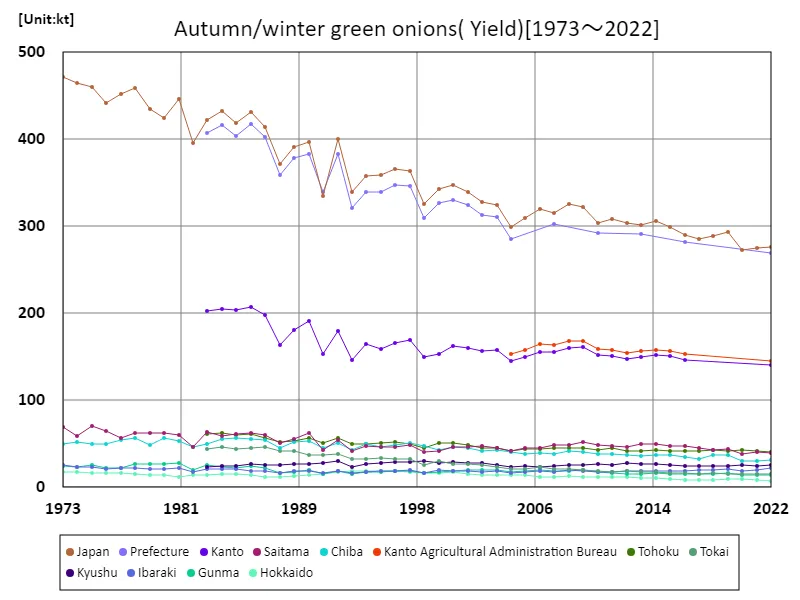

The maximum is 471kt[1973] of Japan, and the current value is about 58.7%
Autumn/winter onion harvest volume (by prefecture).
The latest 2022 data on leafy vegetable harvests in Japanese agriculture shows that Saitama Prefecture recorded the highest overall yield, at 39.9kt. This figure is the highest ever, demonstrating Saitama Prefecture’s vital role in leafy vegetable production. The fact that Saitama Prefecture has the largest production suggests that the climate and soil conditions in the region are suitable for growing leafy vegetable crops. Saitama Prefecture’s advanced agricultural technology and production system will also be taken into consideration. On the other hand, details about production volumes in other prefectures were not provided, making it difficult to fully grasp national trends and characteristics. However, Saitama Prefecture’s production reached an all-time high, suggesting that demand for leafy vegetables may be stabilizing. In the future, it will be important to improve production efficiency in each region, including Saitama Prefecture, and to select cultivated varieties that meet demand.
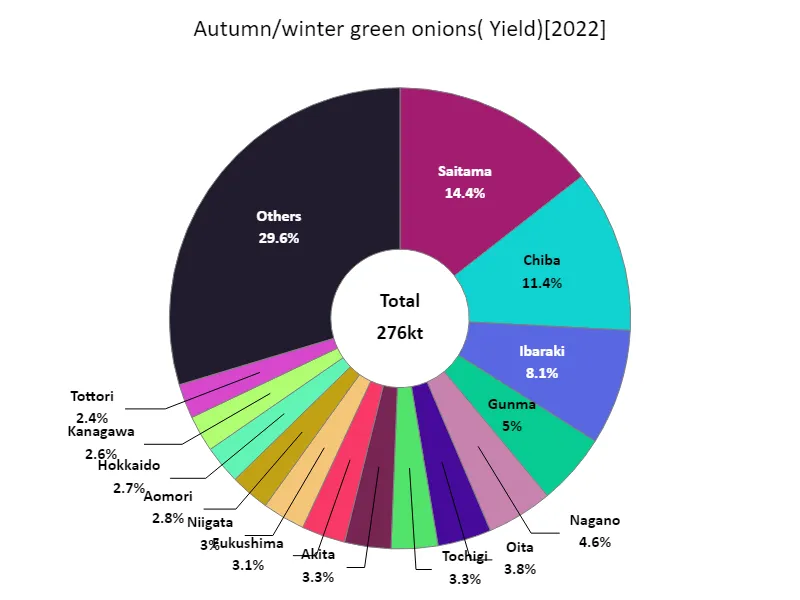

The maximum is 39.9kt of Saitama, the average is 5.88kt, and the total is 276kt
Area planted with autumn/winter onions (main data).
In Japanese agriculture, the area planted with autumn and winter onions nationwide reached a record peak of 21.2 kha in 1973. However, in the following decades, the area under cultivation has tended to decline. As of 2022, the area cultivated nationwide has fallen to about 64.6% of its peak level. The decline is due to the urbanization of farmland, a decline in the agricultural workforce, and changes in demand. The decline in agricultural land due to urbanization has a direct impact on the area under cultivation. There may also be a shift to other crops and production areas due to changes in demand. On the other hand, there is also a trend toward increased demand for local products due to the promotion of local agriculture and the spread of direct sales stores. In the future, it will be important to make efficient use of cultivated area, cultivate varieties that meet demand, and disseminate information to consumers.
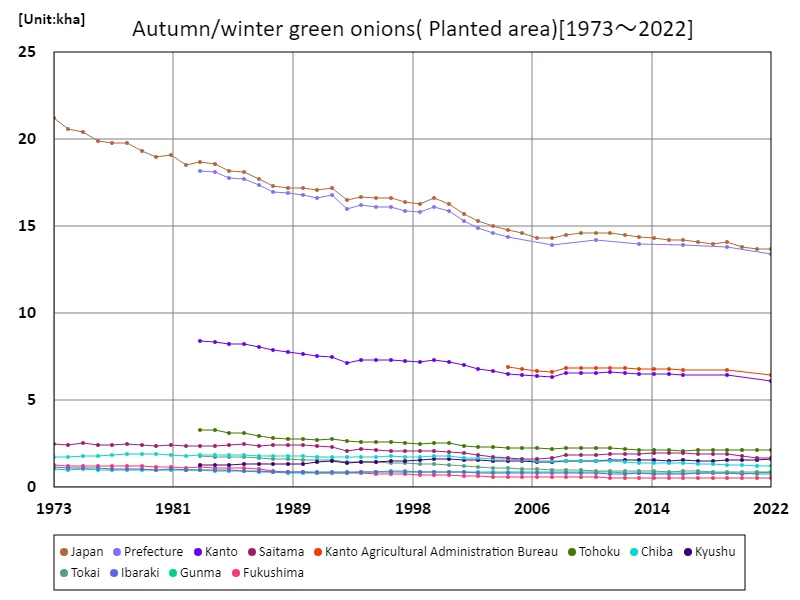

The maximum is 21.2kha[1973] of Japan, and the current value is about 64.6%
Areas planted with autumn/winter onions (by prefecture).
In Japanese agriculture, Saitama Prefecture recorded the largest area planted to leafy vegetables in 2022, at 1.67 kha. Saitama Prefecture’s position as the largest suggests that this region plays a particularly important role in the cultivation of leafy vegetables. It is highly likely that Saitama Prefecture’s climate and soil conditions are suitable for growing leafy vegetables. Saitama Prefecture’s advanced agricultural technology and production system will also be taken into consideration. No details were provided on the acreage of other prefectures, making it difficult to get a full picture of national trends and characteristics; however, Saitama has the largest acreage, indicating the importance of leafy vegetables to the demand and market in the region. In the future, it will be important to improve production efficiency in each region, including Saitama Prefecture, and introduce cultivation techniques that meet demand.


The maximum is 1.67kha of Saitama, the average is 291ha, and the total is 13.7kha
Autumn/winter onion shipping volume.
In Japanese agriculture, Saitama Prefecture recorded the highest overall shipment volume of autumn/winter onions in 2022, at 33kt. The average shipment was 4.67kt, bringing the overall total to 219kt. Saitama Prefecture has the largest shipping volume, which indicates that this region is a major producer of autumn and winter onions. Saitama Prefecture has the potential to have high production capacity and technology in the cultivation of leafy vegetables. In addition, nationwide shipments of autumn and winter onions are stable, suggesting that supply is adequate to meet demand. This stable shipment volume not only meets consumer demand, but also helps stabilize farmers’ incomes. However, production volumes may become unstable due to changes in demand or weather conditions. For this reason, it is important to introduce risk management measures, such as diversifying production areas and improving cultivation techniques. In the future, there will be a need to develop sustainable agricultural production systems.
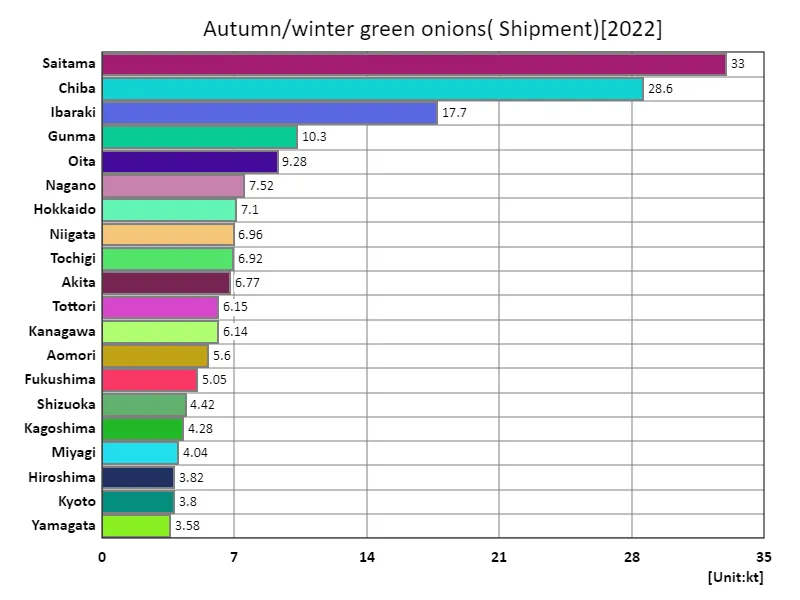

The maximum is 33kt of Saitama, the average is 4.67kt, and the total is 219kt
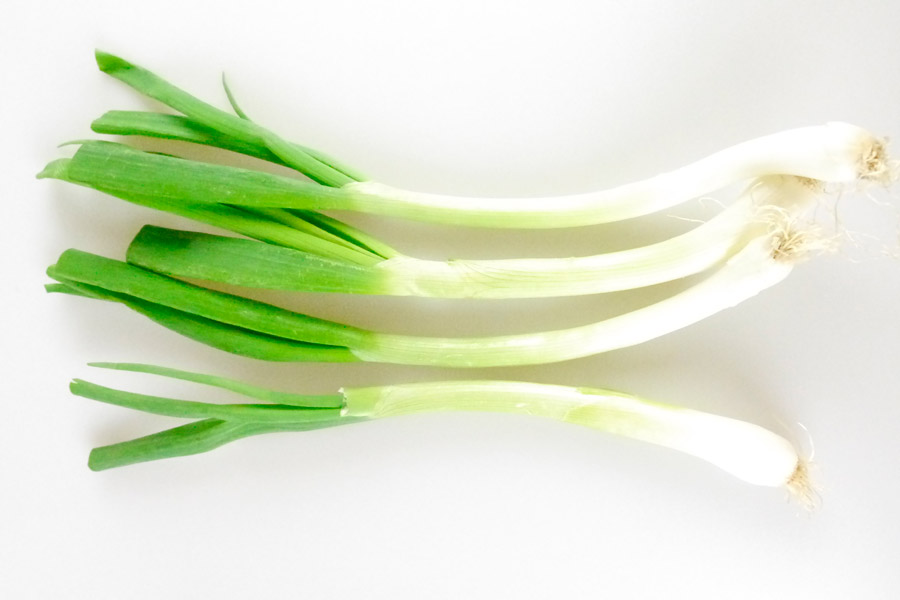


Comments